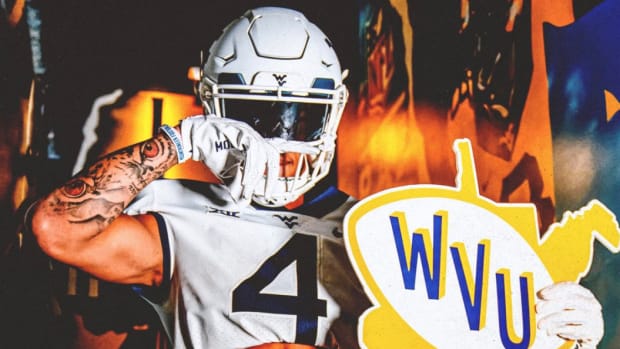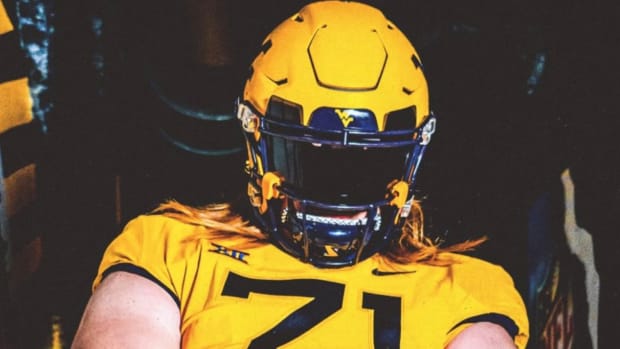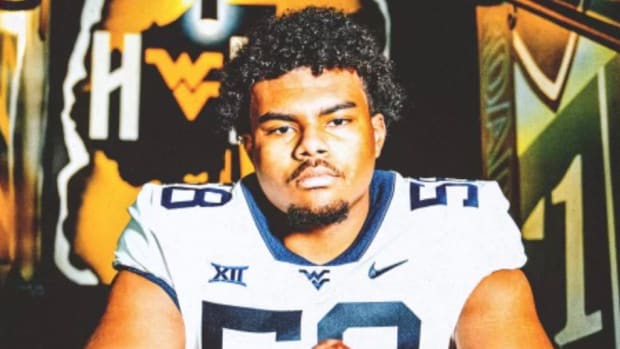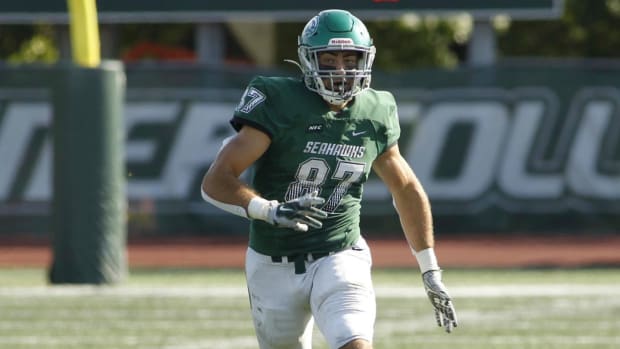The 10 Best Players From the Dana Holgorsen Era
With Neal Brown now officially minted as West Virginia's head coach, everyone is [rightfully] looking ahead to the next chapter of Mountaineer football. While Dana Holgorsen's tenure will forever remain divisive across the fan base, one thing that is not up for debate is that the red bull wizard was able to lure some incredibly talented players to Morgantown who were largely responsible for the majority of the brighter spots over the last eight years.
To be clear, this list will not include players that Holgorsen inherited from the late/great Bill Stewart and will only focus on those players he directly recruited to Morgantown. Best to get that out in the open before you, in your utter disgust, disavow anything I have to say because Tavon Austin doesn't show up here. Second, this has nothing to do with Dana Holgorsen's legacy as a head coach at West Virginia. This is about the players that have justifiably etched their names in the pantheon of Mountaineer greats and their individual contributions as members of Mountaineer nation.
10. Charles Sims, RB: Sims, who spent three years churning through defenses at Houston, spent one very successful year in Morgantown. If it takes you a second to recall Sims' exploits, it's likely because in 2013 the Mountaineers posted a lowly 4-8, lost in Lawrence, KS and missed out on a bowl altogether. Don't blame Sims, though- the Houston native tallied 1,496 yards and 14 touchdowns and was the primary thruster in an otherwise lackluster offensive machine. Sims' stay at West Virginia was all too brief and his otherwise great single season was largely overshadowed by one of the worst squads the Mountaineers have featured since the beginning of the Rich Rodriguez era. It's a real pity, considering the now Tampa Bay Buc was one of the Big 12's best backs that year and could have done much more had the clock not run out on his college career. Had Sims elected to transfer at almost any other point, he would have likely placed higher on this list.
9. Rasul Douglas, CB: In the most pass-heavy of all the major conferences, life in the Big 12 is double tough if you're one of the unfortunate defenses that doesn't feature a lockdown corner. In 2016, West Virginia most certainly had just that in former JUCO standout Rasul Douglas. In West Virginia's only 10 win season since joining the Big 12, Douglas amassed an astounding (and nation-leading) eight interceptions to go along with 77 total tackles. Simply put, Douglas was a maverick edge defender. Standing long at 6'2" and possessing great athleticism, Douglas, opposite fellow star corner Daryl Worley, went from relative unknown to future third round pick seemingly overnight. Had Douglas been eligible for a third year of collegiate play, it's not asinine to think that the now Philadelphia Eagle would have been a first round talent, nor is it a reach to label the NJ native as the best cornerback to play at West Virginia since Adam 'Pacman' Jones.
8. Wendell Smallwood, RB: It's hard to put a price on consistency and even more difficult to ascribe value to versatility. With that in mind, one could reasonably argue that Wendell Smallwood's career in Morgantown was invaluable. Appearing in 48 games during his college career, Smallwood racked up 3,080 yards from scrimmage featuring as both a running back and slot receiver. The Delaware native, who has a super bowl ring with the Philadelphia Eagles, did a little bit of everything for West Virginia. Between his shiftiness, sure hands and burst, Smallwood was an indispensable part of the Mountaineers Air Raid offense before declaring for the NFL draft after his junior year. Despite having to split carries with fellow backs Rushel Shell, Dreamius Smith and Charles Sims throughout the entirety of his career, Smallwood was able to emerge as a true multiple look threat for the 'Eers and remains a model of versatility, especially in a football world that is rapidly becoming more spread-heavy and wide open.
7. Nick Kwiatkoski, LB: No West Virginia player in recent memory, with the exception of a certain former quarterback, saw more success post-position switch than linebacker Nick Kwiatkoski. The Pennsylvania native originally arrived in Morgantown as a run-stop safety. Defensive boss Tony Gibson had other plans, however, and tasked 'Kwit' with beefing up to linebacking proportions. Three seasons and 267 tackles later, its fair to say that the position change benefited everyone on the Mountaineers defense. Now in the two-deep for the Chicago Bears, Kwiatkoski was ever-present around the ball and made the most out of his defensive back days to be a constant presence in pass defense across the middle of the field. Kwiatkoski, along with equally prolific linebacker Al-Rasheed Benton, provided years of solid linebacker play behind an often up-and-down defensive line. Great at the point of attack and athletic enough to make up ground in pursuit, Nick Kwiatkoski was quietly a defensive force for West Virginia and a great example of what buying in can earn you.
6. Yodny Cajuste, LT: Linemen, especially on the offensive side of the ball, are notoriously hard to rate in a metrics-driven world. Given how teams in the Big 12 live and die depending on quarterback play, though, a cornerstone at the blindside is absolutely essential. Since arriving from historic pipeline machine Miramar HS in south Florida, the once budding basketball star will leave Morgantown as one of the best offensive linemen the Mountaineers have fielded since Dan Mozes took home the Remington trophy well over a decade ago. Cajuste, at 6'5" and 320 pounds, brought exceptional athleticism to the left tackle position and was a key component in propelling a West Virginia passing attack that produced over 4,700 yards the last two seasons. Cajuste's efforts on the offensive front were good enough to earn him All-Big 12 first team bon-a-fides along with an invite to the senior bowl and multiple first round projections in the 2019 draft. For a kid who only started playing football his senior year of high school and missed the entirety of the 2016 season with an ACL injury, those superlatives are beyond impressive. While West Virginia has had some good offensive linemen in recent memory (see: Quinton Spain, Mark Glowinski, Kyle Bosch), there should be no argument that Cajuste is certifiably great and did the essential dirty work that sprung an extensive reel of highlight plays.
5. Kevin White, WR: If any position during the Holgorsen era could be accused of having an over-abundance of talent, it would be wide receiver. Guys like Shelton Gibson, Daikiel Shorts, Mario Alford and Gary Jennings were very good and, in more than a couple instances, outstanding. But in terms of sheer prowess and making waves nationally, Kevin White set the standard during the reign of Air Raid and red bull. White, the eldest of three brothers who would all play under the mountain state banner, had an absolutely show-stopping 2014 campaign where he hauled in 109 receptions for 1,447 yards and 10 touchdowns. To further put it into perspective, he essentially tripled his production from year one to year two in Morgantown. That's less a jump than it is a sub-sonic launch between continents. Standing a rock-solid 6'3" and 220 pounds, the eldest White brother used his imposing frame and 4.3 speed to morph into an on-field nightmare. White would ultimately lose out to Alabama receiver Amari Cooper for the Biletnikoff award but, as recompense, was a first round draft selection by the Chicago Bears. Between the dreadlocks flowing in the wind and the no.11 jersey searing a white-hot lane through opposing defenses, Kevin White will never not be electric.
4. David Sills V, WR: Some career arcs and the stories that they center around are so good, so uncommon, that they reverberate for years and years down the line. David Sills' story qualifies. The one-time quarterback prodigy that was destined to play at USC only to land in Morgantown and take up wide receiving as an afterthought will leave behind a towering legacy in West Virginia. In two full seasons and two tours of duty with the Mountaineers, Sills amassed 1,966 yards and 33 touchdowns. To further clarify, 33 trips to the end zone in 125 receptions means no. 13 was tallying a touchdown roughly every four times he touched the ball. Since 2017, No other receiver in college football was on the money like Sills. It wasn't just the frequency with which Sills hit pay dirt, either. It was the effortless, galloping sprints in the open field and the constant, posterizing theatrics that left defenders helpless in his wake. Grinning wide, horns down and living rent-free beyond the pylons, David Sills will be remembered as one of the all-time great receivers to have brandished the flying WV.
3. Karl Joseph, S: You don't need me to tell you that defense can be hard to come by in the Big 12. It's hard living for defensive backs in particular. Every now and then, though, a born-to-destroy defender bursts through the fold and makes even the most slippery skill player think twice before running deep into enemy territory. One of the first defensive players signed by Dana Holgorsen, Karl Joseph arrived from Orlando, FL and immediately made his intentions clear. Hit after body-dissolving hit, Karl Joseph looked less human and more like a piece of cutting-edge ballistic hardware. When you consider that his senior campaign, in which he was leading the nation with five INT's, was cut short four games in after an ACL tear, his career totals of 274 tackles and 16 TFL's are that much more jarring. While the Holgorsen era featured several ball-hawking secondary players including KJ Dillon and most recently the lauded Kyzir White, Karl Joseph's tape elevates him to a different level. A future first rounder, Joseph's exploits on the field still make people wince. A multiple All-American and possible self-aware iron man suit, Karl Joseph is a legendary figure in Mountaineers history.
2. David Long, Jr, LB: 2018 Big 12 defensive player of the year. All-American. Seventh nationally in 2018 with 79 solo tackles. a Big 12-leading 20 tackles for loss. Incessant. Unwavering. An absolute problem for each and every person who has ever had to block him. Long, a native of Cincinnati, was a three star prospect out of Winton Woods HS who was largely passed over by the majority of college's blue bloods. From the moment he sprung a game-defining tackle for loss against Kansas State in 2016 to the final seconds of West Virginia's loss to Syracuse in Orlando several weeks ago, Long has been not only the beating heart of West Virginia's defense, but as good an ambassador as the program has ever had. 246 career tackles, 39.5 of which were for loss and a Ferrari-grade motor for which no metric exists. We're not talking about a Ray Lewis-type player running around at 250 pounds, mind you. At 5'11" and 220 pounds, Long shouldn't be built for the line of work he's in, yet all he's done is excel. Regardless of the disparity in size, weight and tangible mass, Long would routinely outplay and outmaneuver opposing players to the point of frustration. David Long's odds at NFL success are anyone's guess. No doubt the talking heads will say he's too small, not fast enough, not strong enough. If his overwhelming success at the collegiate level is any indication, David Long will prove everyone wrong all over again. Dana Holgorsen never recruited a more relentless player to West Virginia and I doubt he'll ever do so anywhere else.
1. Will Grier, QB: If you're one of the fans still hung up on the inability of Holgorsen and his staff to recruit elite quarterback talent out of the high school ranks, I can't help you. If you are a fan of talent, regardless of how, why or when it landed at WVU, then this is for you. Will Grier was one of the most coveted quarterback prospects in the nation coming out of Davidson Day in Charlotte and for good reason. He was a prolific, record-setting high school player who possessed a confidence under center that belied his years. Fast forward through a successful freshman campaign at Florida, a suspension and ultimately, a tumultuous transfer out of Gainesville, Grier was given full control of West Virginia's offense. In less than two full seasons with the Mountaineers, Grier unleashed a merciless battery of big plays on opposing defenses, piling up 7,354 yards and 76 touchdowns. More impressively, he ranks 16th all-time nationally in total yards per play (8), ninth nationally in career passer efficiency rating (165.2) and 14th nationally in career passing yards per attempt (9.1). Only Marc Bulger and Geno Smith, both of whom logged four years' worth of stats at West Virginia, outpace Grier in the majority of the school's single season and career passing records. While the win total from Grier's two years in Morgantown point to a team that underachieved, the NC native's efforts on the field were undeniably prolific. To this day, Major Harris is the only player in WVU history to finish higher in Heisman Trophy voting than Grier and had it not been for a late season surge by Ohio State and the Tide buoying Tua, Grier would have been on hand in New York city. Say what you will about his final win total, or his election to bypass his final college game to prepare for his NFL future. Will Grier made a home in Morgantown and, regardless of how brief his stay, he'll leave as arguably the best passing quarterback in program history.




